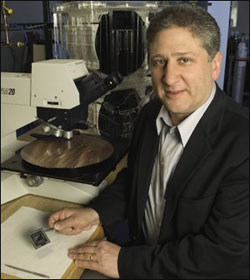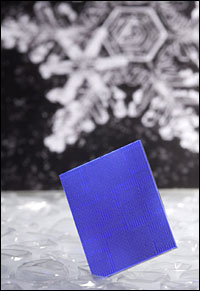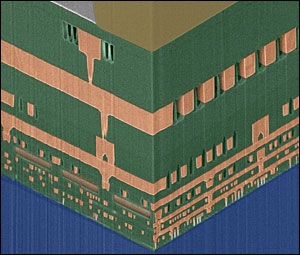
Chip Advance Uses Nature's Patterning Process
ARMONK, N.Y., May 4, 2007 -- The natural pattern-creating process that forms seashells, snowflakes and tooth enamel has been used to create uniform patterns of trillions of nanoscale holes in a microprocessor. The technique allows electric signals on conventionally manufactured computer chips to flow faster or use less energy, its creators said.

IBM Fellow Dan Edelstein with an experimental version of the company's latest-generation microprocessor. The chip uses a vacuum to insulate the miles of wiring that connect its millions of transistors. The "airgaps" were created using a self-assembly technology that creates a uniform pattern of trillions of nanoscale holes in a wafer. The technique draws on nature's ability to form intricate patterns such as snowflakes and seashells. (Images courtesy IBM)
Armonk-based IBM yesterday announced the first-ever application of a self-assembling nanotechnology to conventional chip manufacturing, borrowing a process from nature to form the holes, creating insulating vacuums around the miles of nanoscale wires packed next to each other inside each computer chip.
In chips running in the company's labs using the technique, the researchers have proven that the electrical signals on the chips can flow 35 percent faster, or the chips can consume 15 percent less energy, compared to the most advanced chips using conventional techniques.
The patented self-assembly process moves a nanotechnology manufacturing method that had shown promise in laboratories into a commercial manufacturing environment for the first time, providing the equivalent of two generations of Moore's Law wiring performance improvements in a single step, using conventional manufacturing techniques, the company said.

IBM has created experimental versions of its latest Power6 microprocessor using self-assembly techniques to create a vacuum between the miles of on-chip wiring. The company has moved self-assembly out of the labs and into a commercial manufacturing environment. It expects to begin manufacturing servers based on airgap technology in 2009.
This new form of insulation, commonly referred to as "airgaps" by scientists, is a misnomer, as the gaps are actually a vacuum, absent of air. The new technique causes a vacuum to form between the copper wires on a computer chip, allowing electrical signals to flow faster, while consuming less electrical power. The self-assembly process enables the nanoscale patterning required to form the gaps; this patterning is considerably smaller than current lithographic techniques can achieve.
A vacuum is believed to be the ultimate insulator for what is known as wiring capacitance, which occurs when two conductors, in this case adjacent wires on a chip, sap or siphon electrical energy from one another, generating undesirable heat and slowing the speed at which data can move through a chip.
Until now, chip designers often were forced to fight capacitance issues by pushing ever more power through chips creating, in the process, a range of other problems. They have also used insulators with better insulating capability, but these insulators have become tenuously fragile as chip features get smaller and smaller, and their insulating properties do not compare to those of a vacuum.
The self-assembly process already has been integrated with IBM's state-of-the-art manufacturing line in East Fishkill, N.Y., and is expected to be fully incorporated in its manufacturing lines and used in chips in 2009. The chips will be used in the company's server product lines and thereafter for chips built for other companies.
"This is the first time anyone has proven the ability to synthesize mass quantities of these self-assembled polymers and integrate them into an existing manufacturing process with great yield results," said Dan Edelstein, IBM Fellow and chief scientist of the self- assembly airgap project. "By moving self-assembly from the lab to the fab, we are able to make chips that are smaller, faster and consume less power than existing materials and design architectures allow."
Edelstein led the team that invented the technique to use copper wiring in computer chips instead of aluminum, now a standard method for producing chips.
The secret of the breakthrough lies in how the scientists moved the self-assembly process from the laboratory to a production manufacturing environment in a way that can potentially yield millions of chips with consistent, high performance results.
Today's chips are manufactured with copper wiring surrounded by an insulator, which involves using a mask to create circuit patterns by beaming light through the mask and later chemically removing the parts that are not needed.

This microprocessor cross section shows empty space in between the chip's wiring. Wires are usually insulated with a glass-like material. IBM has integrated self-assembly techniques, long confined to laboratories, with its manufacturing lines to create a test version of its latest microprocessors that use vacuum gaps to insulate the miles of nanoscale wire that connect hundreds of millions of transistors. The gaps help reduce electrical interference, raise processor performance, and lower energy consumption.
The new technique to make airgaps by self-assembly skips the masking and light-etching process. Instead scientists discovered the right mix of compounds, which they pour onto a silicon wafer with the wired chip patterns, then bake it.
This patented process provides the right environment for the compounds to assemble in a directed manner, creating trillions of uniform, nanoscale holes across an entire 300-mm wafer. These holes are just 20 nm in diameter, up to five times smaller than would be possible using today's most advanced lithography technique.
Once the holes are formed, the carbon silicate glass is removed, creating a vacuum between the wires -- know as the airgap -- allowing the electrical signals to either flow 35 percent faster, or the chips can consume 15 percent less energy.
Self-assembly is a concept scientists around the world have been studying as a potential technique to create materials useful for building computer chips. The concept occurs in nature every day: it is how enamel is formed on our teeth, it's the process that creates seashells and it's what transforms water into complex snowflakes. The major difference is, while the processes that occur in nature are all unique, IBM has been able to direct the self-assembly process to form trillions of holes that are all similar.
The technology can be incorporated into any standard CMOS manufacturing line, without disruption or new tooling, the scientists said.
The self-assembly process was jointly invented between IBM's Almaden Research Center in San Jose, Calif., and the T.J. Watson Research Center in Yorktown, N.Y. The technique was perfected for future commercial production at the College of Nanoscale Science and Engineering of the University at Albany, within the Albany NanoTech facilities and at IBM's Semiconductor Research and Development Center in East Fishkill, N.Y.
For more information, visit: www.ibm.com
/Buyers-Guide/IBM-Corp/c6415